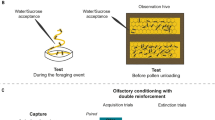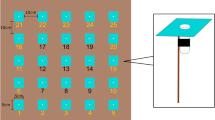Summary
The honey bee colony presents a challenging paradox. Like an organism, it functions as a coherent unit, carefully regulating its internal milieu. But the colony consists of thousands of loosely assembled individuals each functioning rather autonomously. How, then, does the colony acquire the necessary information to organize its work force? And how do individuals acquire information about specific colony needs, and thus know what tasks need be performed? I address these questions through experiments that analyze how honey bees acquire information about the colony's need for pollen and how they regulate its collection. The results demonstrate features of the colony's system for regulating pollen foraging: (1) Pollen foragers quickly acquire new information about the colony's need for pollen. (2) When colony pollen stores are supplemented, many pollen foragers respond by switching to nectar foraging or by remaining in the hive and ceasing to forage at all. (3) Pollen foragers do not need direct contact with pollen to sense the colony's change of state, nor do they use the odor of pollen as a cue to assess the colony's need for pollen. (4) Pollen foragers appear to obtain their information about colony pollen need indirectly from other bees in the hive. (5) The information takes the form of an inhibitory cue. The proposed mechanism for the regulation of pollen foraging involves a hierarchical system of information acquisition and a negative feedback loop. By taking advantage of the vast processing capacity of large numbers of individuals working in parallel, such a system of information acquisition and dissemination may be ideally suited to promote efficient regulation of labor within the colony. Although each individual relies on only limited, local information, the colony as a whole achieves a finely-tuned response to the changing conditions it experiences.
Similar content being viewed by others
References
Al-Tikrity WS, Benton AW, Hillman RC, Clarke WW Jr (1972) The relationship between the amount of unsealed brood in honeybee colonies and their pollen collection. J Apic Res 11:9–12
Barker RJ (1971) The influence of food inside the hive on pollen collection by a honeybee colony. J Apic Res 10:23–26
Brooks CM, Koizumi K (1974) The hypothalamus and control of integrative processes. In: Mounteastle VB (ed) Medical physiology. C.V. Mosby, St. Louis, pp 813–836
Cale GH Jr (1968) Pollen gathering relationship to honey collection and egg-laying in honey bees. Am Bee J 108:8–9
Cannon WB (1932) The wisdom of the body. WW Norton, New York
Crailsheim K (1990) The protein balance of the honey bee worker. Apidologie 21:417–429
Crailsheim K (1991) Interadult feeding of jelly in honeybee (Apis mellifera L.) colonies. J Comp Physiol B 161:55–60
Crailsheim K, Stolberg E (1989) Influence of diet, age and colony condition upon intestinal proteolytic activity and size of the hypopharyngeal glands in the honeybee (Apis mellifera L.). J Insect Physiol 35:595–602
Crailsheim K, Schneider LHW, Hrassnigg N, Bühlmann G, Brosch U, Gmeinbauer R, Schöffmann B (1992) Pollen consumption and utilization in worker honey bees (Apis mellifera carnica): dependence on individual age and function. J Insect Physiol 38:409–419
Fewell JH, Winston ML (1992) Colony state and regulation of pollen foraging in the honey bee, Apis mellifera L. Behav Ecol Sociobiol 30:387–393
Filmer RS (1932) Brood area and colony size as factors in activity of pollination units. J Econ Entomol 25:336–343
Free JB (1967) Factors determining the collection of pollen by honeybee foragers. Anim Behav 15:134–144
Free JB (1979) Managing honeybee colonies to enhance the pollen-gathering stimulus from brood pheromones. Applied Animal Ethology 5:173–178
Free JB, Williams IH (1971) The effect of giving pollen and pollen supplements to honeybee colonies on the amount of food collected. J Apic Res 10: 87–90
Hull DL (1980) Individuality and selection. Annu Rev Ecol Syst 11:311–332
Jeanne RL (1986) The organization of work in Polybia occidentalis: cost and benefits of specialization in a social wasp. Behav Ecol Sociobiol 19:333–341
Jeffree EF, Allen MD (1957) The annual cycle of pollen storage by honey bees. J Econ Entomol 50:211–212
Lacre O van, Martens N (1971) Influence d'une diminution artificielle de la provision de proteines sur l'activite de collete de la colonic d'abeilles. Apidologie 2:197–204
Lindauer M (1952) Ein Beitrag zur Frage der Arbeitsteilung im Bienenstaat. Z Vergl Physiol 34:299–345
Lindauer M (1954) Temperaturregulierung and Wasserhaushalt im Bienenstaat. Z Vergl Physiol 36:391–432
Lloyd JE (1983) Bioluminescence and communication in insects. Annu Rev Entomol 28:131–160
Moeller FE (1972) Honey bee collection of corn pollen reduced by pollen feeding in hive. Am Bee J 112:210–212
Moritz B, Crailsheim K (1987) Physiology of protein digestion in the midgut of the honeybee (apis mellifera L.). J Insect Physiol 12:923–931
Mountcastle VB (1974) Medical physiology. C.V. Mosby, St. Louis
Rosov SA (1944) Food consumption by bees. Bee World 25:94–95
Seeley TD (1985) Honeybee ecology. Princeton University Press, Princeton, NJ
Seeley TD (1989a) The honey bee colony as a superorganism. Am Sci 77:546–553
Seeley TD (1989b) Social foraging in honey bees: how nectar foragers assess their colony's nutritional status. Behav Ecol Sociobiol 24:181–199
Sokal RR, Rohlf FJ (1981) Biometry, 2nd edn. Freeman, New York
Sorensen AA, Busch TM, Vinson SB (1985) Control of food influx by temporal subcastes in the fire ant, Solenopsis invicta. Behav Ecol Sociobiol 17:191–198
Southwick EE (1991) The colony as a thermoregulating superorganism. In: Goodman LJ, Fisher RC (eds) The behaviour and physiology of bees. CAB International, Wallingford, UK
Tschinkel WR (1988) Social control of egg-laying rate in queens of the fire ant, Solenopsis invicta. Physiol Entomol 13:327–350
Visscher PK, Seeley TD (1982) Foraging strategy of honeybee colonies in a temperate deciduous forest. Ecology 63:1790–1801
Wheeler WM (1928) The social insects: their origin and evolution. Kegan Paul, Trench, Trubner & Co, London
Wilson DS, Sober E (1989) Reviving the superorganism. J Theor Biol 136:337–356
Winston M (1987) The biology of the honey bee. Harvard University Press, Cambridge, MA
Author information
Authors and Affiliations
Rights and permissions
About this article
Cite this article
Camazine, S. The regulation of pollen foraging by honey bees: how foragers assess the colony's need for pollen. Behav Ecol Sociobiol 32, 265–272 (1993). https://doi.org/10.1007/BF00166516
Received:
Accepted:
Issue Date:
DOI: https://doi.org/10.1007/BF00166516




